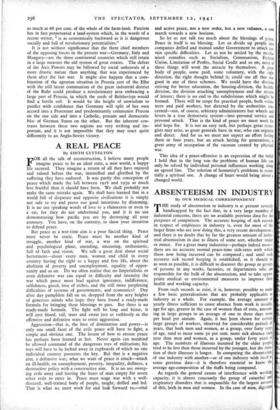THE LAND-QUESTION IN EUROPE
By C. W. GUILLEBAUD
A S soon as the war of 1914-18 ended (and in some cases, 11 for instance in Greece, even earlier) the example of the Bolshevik Revolution forced the surrounding countries of Eastern Europe to adopt agrarian reform, and to break up and re-distribute the great landed estates. This was the period when what is popularly known as the Green Revolution flour- ished, and men such as Alexander Stambolisky of Bulgaria were advocating a reconstruction of national life on the basis of peasant co-operatives in place of the old type of political parties. Stambolisky, indeed, was one of the earliest supporters of the system of representation by economic groups which later became the theoretical basis of the Italian Co-operative State, and it was under his influence that the International Union of Peasant Parties was first formally organised at the i6th Congress of the Bulgarian Peasant Union in February, 1921. All over Eastern Europe, from Finland in the north to Greece in the south, with the single exception of Hungary, the great landowners were dispossessed and their estates divided up amongst the land-hungry peasants. Even in Poland, where the progress was slowest and encountered the greatest opposition, agrarian reform was about two-thirds complete by the end of I 1938, and it was calculated that it would have been completed t within another five or six years after that date.
Owing to the competition of cheap overseas-foodstuffs in I the world-markets, the contraction of demand in the chief j European consuming countries and, most of all, the growth of 1 population in Eastern European countries themselves, this redis- tribution of land did not bring to the peasants the positive advantages that might have been hoped from it. Many who had been labourers on the large estates were unable to obtain holdings of their own and were driven to seek a livelihood In the towns. Nevertheless, a social structure was built up on a broad basis of peasant proprietorship, which proved to be stable in the face of violent economic and political changes, Including the defeat of the peasants' own hopes of establishing a Peasant-controlled political system. Now a very interesting question arises. Why did Russian Communism stop at the frontiers of Russia, and how does it come that these poor and struggling countries, only just emerged from the chaos of war, remained content with a mere measure of land-redistribution, instead of adopting the full- blooded Communism of their great neighbour to the East? There is no single answer to this question, but the following seem to have been the most important factors in determining the subsequent course of history in these countries: Firstly, the driving forces of Bolshevism were urban and industrial, and the hierarchy of councils (Soviets) set up in Russia gave the city minority a degree of power which was quite dispropor- tionate to its members. Secondly, the two pillars of peasant society are the land and religion ; the Russians nationalised the land, and in the early days of war-Communism used forcible methods to requisition the produce of the peasants, while the later policy of collective farming involved the aboli- tion of peasant-ownership; at the same time the persecution of religion was an offence to sentiment outside. Finally, there was a strong nationalist feeling within these new States, whereas Bolshevism, especially in its initial phase, stressed the inter- national rather than the national aspects of the Red Revolu- tion. Despite a considerable measure of industrialisation in some cases, all these Eastern European countries remain essen- tially peasant-States, grossly overpopulated and poor, but unable to copy either the Russian policy of large-scale indus- trialisation and urbanisation (because they lack the raw mate- rials and sources of power) or the policy of collective agricul- ture (because rainfall-conditions and the nature of the land favour small-scale rather than large-scale farming).
It has been mentioned above that Hungary was the one exception to the general rule—" an island of latifundia in a green sea of agrarian reform," as it has been described—where before the present war between one quarter and one third of the whole cultivated area was still held in the form of large estates above 1,400 acres. But besides Hungary there are two other great areas of latifundia on the Continent of Europe —Prussia east of the Elbe (the home of the Junkers), and Italy, especially in the centre and in the south. In Italy, for example, 3.4 per cent. of the total number of proprietors own as much as 68 per cent. of the whole of the farm-land. Fascism has in fact perpetuated a land-system which, in the words of a recent writer, "is as economically backward as it is dangerous socially and full of revolutionary potentialities."
It is not without significance that the three chief members of the opposing forces in the present war—Germany, Italy and Hungary—are the three continental countries which still retain in a large measure the old system of great estates. The defeat of the Axis Powers may be followed by social unheavals of a more drastic nature than anything that was experienced by them after the last war. It might also happen that a com- bination of the agrarian situation in Prussia east of the Elbe with the still latent communism of the great industrial district of the Ruhr could produce a revolutionary area embracing a large part of Prussia, in which the seeds of Bolshevispa would find a fertile soil. It would be the height of unwisdom to predict with confidence that Germany will split of her own accord into a Protestant and predominantly communist Prussia on the one side and into a Catholic, peasant and democratic bloc of German States on the other. But the inherent con- trasts between these two regions are very striking and im- portant, and it is not impossible that they may react quite differently to an Anglo-Soviet victory.



























 Previous page
Previous page